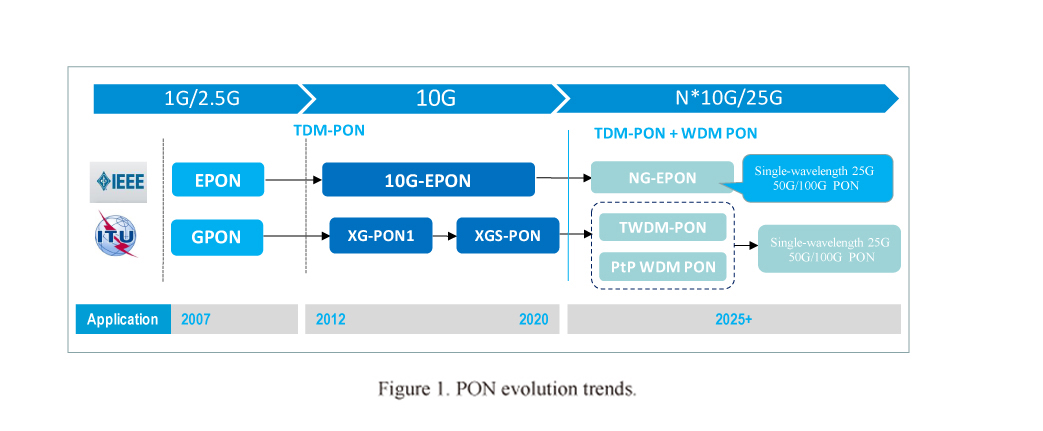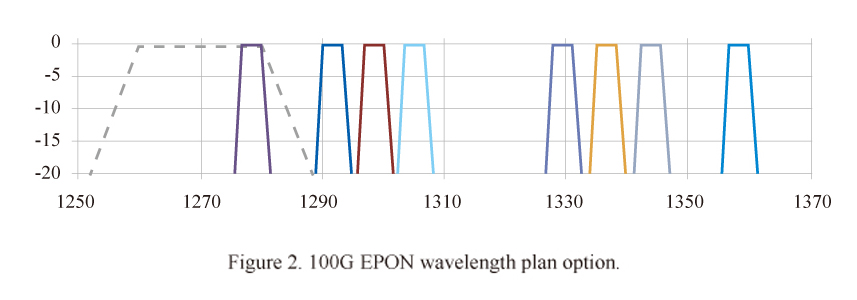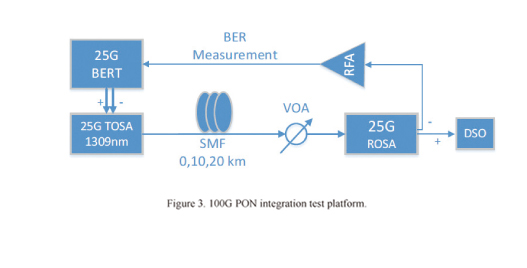An Analysis of 100G PON Application Prospects
As smart devices, 4K/8K streaming videos, and 4G/5G mobile fronthaul/backhaul high-bandwidth services are widely applied, a passive optical network (PON) must provide higher transmission bandwidth to satisfy the service requirements. Now 25 Gbps optoelectronic devices are increasingly maturing, and 25 Gbps is becoming a standard rate for the next-generation PON (NG-PON). In recent years, high-speed transmission technologies have been extensively studied for the PON system, and multiple methods of implementation have been put forward.
In a bandwidth-limited receiver, a three-level duobinary (DB) signal reduces transmission bandwidth by half compared with a non-return-to-aero (NRZ) signal. In optical and electrical domains, the duobinary transmission system can be applied to low-bandwidth optical devices such as 10 GHz APD at a rate of 25 Gbps. The 4-level pulse amplitude modulation (PAM4) maps 2-bit data into 4-level signals and transmits 25 Gbps data using only half the bandwidth of a NRZ system. Another method is to deliver high-speed data upon low-bandwidth devices using analog equalizers such as FFE filters or DSP such as MLSE. However, the costs of the above-mentioned methods are relatively high.
Progress of NG-PON Standards
The evolution trends of PON defined by IEEE and ITU are shown in Fig.1. The international standard NG-PON2 for 40G PON was released in 2016, but its commercialization process was slowed due to high costs of tunable optical devices and system immaturity. The standardization organizations carried out research into PON evolution trends. In November 2016, IEEE set up a 100G EPON task force named IEEE 802.3ca to work on next-generation high-speed EPON standards that are expected to be released in 2018. The 100G EPON standard defines three MAC-layer rates: 25G, 50G and 100G, among which 25G falls into asymmetric 10G/25G mode and symmetric 25G/25G mode. ITU-T Q2/15 started writing a white paper on the next-generation high-speed PON and studies its access possibilities. From the perspective of bandwidth needs, 10G PON will provide a bandwidth of 100M to 1G per user by 2020. After 2020, 25G PON, NG-PON2, and 50G/100G PON will be gradually commercialized to deliver a bandwidth of 1−10G per user.


100G PON Architecture
The 100G EPON architecture discussed in the IEEE p802.3ca supports MAC-layer rates of 25G, 50G, and 100G. It is recommended to first deploy single-wavelength 25G OLT/ONU and then 50G and 100G OLT/ONU. Due to the performance and commercialization issues of tunable lasers and filters, 100G EPON uses a fixed wavelength and co-exists with the existing 10G PON in the same ODN through wavelength division. At the OLT side, 100G PON uses a wavelength division multiplexer to form a PON OLT port, with each wavelength supporting a rate of 25G at both optical and physical layers. The MAC layer supports multiple rates of 25G, 50G, and 100G. A channel bonding technology must be used to bind multiple 25G physical and optical layers to support higher MAC-layer rates. At the user side, ONUs may have different rates. In addition to coexisting with the existing 10G PON, 100G PON also needs to support 25G, 50G and 100G ONUs.
100G PON Wavelength Plan
The factors to be considered in selecting wavelengths for 25G/100G PON include fiber dispersion, fiber loss, PON compatibility, costs of optical devices, and technical complexity. 25G/100G PON supports three rates: 25G, 50G, and 100G.
ZTE, in alliance with several companies in the industry, puts forward an all-O-band wavelength plan that has been adopted by standard organizations. The wavelength plan has many advantages such as NRZ modulation, no complex dispersion compensation, reusing the 100G Ethernet industry chain, using direct modulated lasers (DMLs) and externally modulated lasers (EMLs), and easy implementation at the physical layer. As C-band and L-band have large dispersion, complex modulation and equalization technologies are needed for dispersion compensation, and its impact on performance and costs still needs to be further researched. Figure 2 shows an all-O-band wavelength plan option. Currently, the wavelength interval and pass-band width have not yet been determined, and the wavelength plan is still under discussion. In the wavelength plan (Fig. 2), the pass-band width for all wavelengths is 3 nm, which can achieve a tradeoff among optical device yields, burst tolerance, and SOA amplification and costs. The uplink wavelength of 25G PON can coexist with that of 10G-EPON in the WDM or TDM mode.

Development of ZTE's 100G PON Prototype
ZTE has started research into 100G PON for some time. It has set up a 100G PON integration test platform that can test key 25G optical devices such as 25G EML, DML, APD, TIA, and burst CDR through the high-speed error detector, high-speed arbitrary waveform generator (AWG), and high-speed sampling oscilloscope. Performance simulation tests for various modulation modes such as NRZ, Duobinary, PAM4, and DMT and for various DSP algorithms can also be implemented on the platform. A commercial 25G EML with a central wavelength of 1309 nm and an extinction ratio of 8.1 dB is used as the transmitter (Fig. 3), and its data payloads are produced by pseudo random bit sequence (PRBS). The result indicates that the receiver sensitivity measured in the case of BER = 10-3 (without FEC) is −28.5 dBm, conforming to the theoretical value. Due to the near-zero-dispersion wavelength, the dispersion penalty measured in the test at a transmission distance of 20 km is less than 1 dB. By adjusting the average transmit power to +7 dBm, the optical power budget can achieve 35 dBm without amplification. Considering the 5 dB WDM insertion loss and 1 dB transmitter and dispersion penalty (TDP), 100G PON can support PR30 (29 dB) power budget.

ZTE successfully demonstrated its 100G EPON prototype at MWC 2017 in Barcelona. In a NG-PON demo network established by ZTE and the Key Laboratory of Specialty Fiber Optics and Optical Access Networks of Shanghai University in the first half of 2017, ZTE verified symmetric single-wavelength 25G and four-wavelength 100G PON systems, implementing smooth evolution from 40G PON to 100G PON. The NG-PON demo network adopts point-to-multipoint tree topology used in PON and supports four rates: asymmetric single-wavelength uplink 10G/downlink 25G, symmetric single-wavelength uplink/downlink 25G, asymmetric four-wavelength uplink 40G/downlink 100G, and symmetric four-wavelength uplink/downlink 100G. The verification shows that symmetric 100G PON OLT and ONU prototypes developed on ZTE's commercial product platform are operating stably with good performance.
Conclusion
ZTE has been actively involved in research and development of 25G/100G PON and has maintained its leading position in PON technologies and market applications. It is one of the earliest initiators for 100G EPON and has put forward many key technical indicators that have been adopted in the industry. ZTE is also an initiator, editor, and contributor of the next-generation high-speed PON technical whitepaper for ITU-T Q2/15. The company has developed symmetric 100G PON OLT and ONU prototypes based on its product platform, promoting the progress of 100G PON research and commercialization.